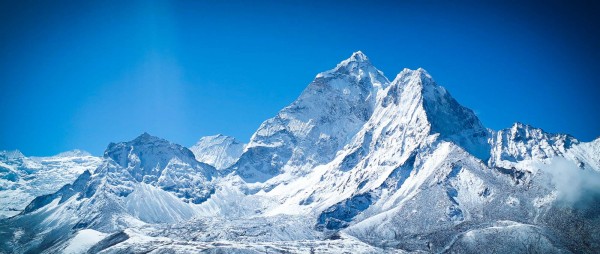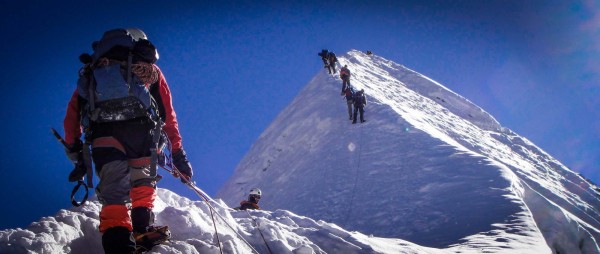Important Information
Region
Everest Region Trek
Duration
9 Days
Max Altitude 4065 meters
Best Season March, April, May and September, October, November
Activity Per Day
4-5 hours per day
Grade
Level 2
Group Size
2 - 12 people
Transportation Jeep/Bus
Pikey Peak lies in the Ramechap district of central Nepal. This trek is getting popular for the sunrise, magnificent view of the majestic mountains of Nepal including Mount Everest, Buddhist monasteries, Sherpa settlements, and the luring green valley. The name Pikey came from the clan deity of Sherpa which resembles the sky over nature. During the mid-summer, locals hike up to the hilltop and offer Tibetan praying flags with the monks from the monasteries to worship their deity to protect them from natural calamities.
Pikey Peak trek offers you to experience the jaw-dropping panoramic view of the Great Himalayas including the Everest ranges, Thamserku, Khangtega, Number Himal, Mera Peak, Ramdung Himal, Manaslu, Dhaulagiri, Gaurishangkar, and Dorje Lakpa from low altitudes. Pikey Peak trek is a perfect alternative to skip the hectic flight of Lukla to experience Mount Everest. Besides that, it is also suitable for new trekkers and hikers.
Picky Peak Trek is an exploration of both Nature and Culture. This package is designed and categorized as a short trek of 7 days. You can minimize this trek by skipping the side trek to the Thuptenchhiling Monastery. Flight back to Kathmandu from Phaplu is optional.
If you are looking for a different itinerary than this then please - Customize Your Trip
Highlights of the Pikey Peak
- Experience Mount Everest from the low altitudes.
- Explore the Sherpa culture.
- Explore the view of the Green Valley and cheese factory.
- One of the best and least crowded trekking destinations.
Include
Kathmandu to Dhap and Salleri to Kathmandu by sharing bus or jeep transfer
Airport pick and drop off (international and domestic)
All trekking permit
3 times meals- breakfast, lunch, and dinner during
English Speaking guide and all his expenses - travel insurance, meals, accommodation, salary, and transfer
Porter to carry luggage
All government the taxes and company service charge
Basic Tea houses Accommodation during trek
Twin/double sharing accommodation in the mountain during the trekking
Exclude
Expenses of personal nature like wifi, hot shower, telephone, telephone.
Travel Insurance
Drinks like coke, Fanta, beer, whiskey, coke, mineral water, hot water, tea, coffee
Tips for guide
All the cost does not mention on above includes.
Flight from Phaplu to Kathmandu
Route Map

Important Information
Note Regarding cost***
If you prefer private transportation like a 4x4 jeep, then you need to pay extra for that.
CHECKLISTS FOR PIKEY PEAK TREK
- Valid passport (valid for six months from the date of your trip)
- MasterCard, Visa Credit, and Debit Cards are accepted in Nepal. However, some cash is highly recommended.
- Mobile (if your cell phone is from CINGULAR USA or ATNT (USA) operators, then your cell phone will work in Nepal.)
- Clothing (Layered clothes, windproof and waterproof jackets, fleece pullovers, thermal base layers, hiking pants, shorts, headwear, footwear, and other items according to your needs)
- Personal Items and Toiletries (First-Aid Kit, Iodine tablets or a UV purifier to treat water, Sun Protection)
- Travel and Health Insurance
- Trekking gear and equipment(if you have your own trekking gear and equipment, such as trekking poles, sleeping bag, and shoes, then you can bring them; else you can rent them in Thamel, Kathmandu). Read more for trekking gears and peak climbing gears.
Guiding, Food, and Lodging
In Nepal, all trekking supplies - Teahouse trekking means staying and eating in local lodges. We stay in single rooms where possible, but often you will have to share. Rooms are basic, normally just a bed with a pillow, blankets. A few have electric lights and all have a spacious dining room-lounge. We eat at teahouses and, although the food is usually plentiful and delicious, the menu is not extensive. They offer a variety of potatoes, rice and noodle dishes, as well as soup and seasonal vegetables. Beers and local spirits are often available, but that will be at your own cost. A variety of cereals, bread, and egg dishes are generally available for breakfast. There are also snacks available such as basic biscuits, chocolate, and soft drinks and in some areas, you will find fresh fruit in season. It is normal to meet your porter in the teahouse where you will stay overnight. So, pack your necessary things in your own day pack.
DRESS CODE FOR VISITING MONASTERIES, AND TEMPLES IN NEPAL
- Shirt (either half or full sleeve)
- Full pants/long skirts
- Any type of shoes with socks
- No Hats, No Umbrella, No Slippers, No t-shirts, No short skirt, and No half-pants
- Photographs allowed in the courtyard only.
Note regarding itineraries
Although we generally adhere to the schedule, the itinerary is subject to change for numerous reasons beyond our control, including weather and terrain conditions, suitable campsite availability, and the group's general fitness level. It is important to understand that our trek is logistically complex and it is not unusual that adjustments be made. Our guide will orient you each evening to the following day's plan; their good judgment is the key to the long history of successful treks that Himalayan Wander Walkers has led till now. Please remember that our ability to make adjustments as needed helps to ensure that your trek is successful.
Frequently Asked Question
Absolutely! The Pikey Peak Trek can be customized to suit your specific needs. Whether you’d like to adjust the duration, add extra rest days, or visit specific spots like monasteries or scenic viewpoints, we can modify the itinerary to create your perfect trekking experience. Just share your preferences, and we’ll craft a tailored route for you: “Customize Your Trip.”
The Pikey Peak Trek is considered moderate in difficulty. While it doesn’t reach the extreme altitudes found in other Everest region treks, it still involves some challenging ascents and descents. The trek reaches a peak elevation of 4,065 meters, making it suitable for trekkers with a good level of fitness. Some acclimatization is recommended to avoid altitude sickness, particularly at higher elevations.
Although the Pikey Peak Trek is relatively straightforward, we highly recommend having a guide. A guide ensures that you stay safe and follow the correct path and enriches your experience by sharing insights into the local culture and area. They can also assist with logistics, particularly if you need to make adjustments due to weather changes or other unforeseen events.
To trek Pikey Peak, you will need the Sagarmatha National Park Entry Permit and the TIMS (Trekkers' Information Management System) card. These are standard permits required for most treks in the Everest region. As the trek doesn’t venture into the higher altitude zones, acquiring the necessary permits is relatively simple.
While the risk of altitude sickness is minimal, it's still possible as the trek reaches 4,065 meters at the summit. To mitigate the risk, acclimatization days are built into the itinerary, especially when passing through higher-altitude villages. It’s essential to hydrate well, eat regularly, and ascend slowly. If you experience symptoms such as headaches or dizziness, inform your guide immediately, who will follow the necessary protocols to ensure your safety.
During the Pikey Peak Trek, you’ll stay in cozy teahouses and lodges along the way. These provide basic but comfortable rooms and serve authentic local food, allowing you to enjoy a cultural experience while trekking through the Everest region.
Yes, there is limited internet access on the Pikey Peak Trek. Mobile network coverage is available in certain regions, and some lodges offer Wi-Fi. For mobile data, you can use Ncell or NTC services. However, internet access may be slower and less reliable as you ascend to higher altitudes.
Essential items for the Pikey Peak Trek include sturdy trekking shoes, warm clothing (as temperatures can drop at higher elevations), a high-quality sleeping bag, water bottles, sunscreen, a hat, energy bars, and a basic first-aid kit. Pack light, but make sure you’re well-prepared for unpredictable weather and the trek’s duration. Read more about trekking gear.
For alternative treks in the Everest region, you could consider the Everest Base Camp Trek, which takes you to the base of the world’s highest peak. The Gokyo Lakes Trek offers spectacular views of Everest and the surrounding peaks, and the Ama Dablam Base Camp Trek provides awe-inspiring views of some of the tallest mountains on Earth. These treks are more challenging but offer exceptional scenery and a deeper immersion into the Everest region.
No questions found matching your search. Try different keywords or browse all questions above.
| {{type.min}} - {{type.max}} Pax {{type.name}} - {{type.desc}} | {{type.display_price}} per people |
Extra prices:
Let us help you decide Inquiry
You might also like

- 14 days
- Everest Region Trek
Everest Base Camp Trek
Everest Base Camp Trek is the ultimate goal of many people (bucket list) and those who have already been there; they rate it as one of the best experiences of their life. Everest Base Camp Trek is an iconic trekking destination in the Himalayas and probably in the world. The world's...



